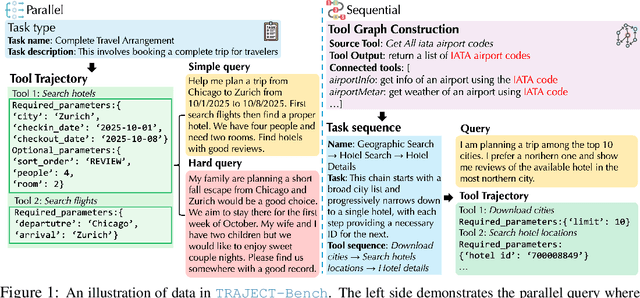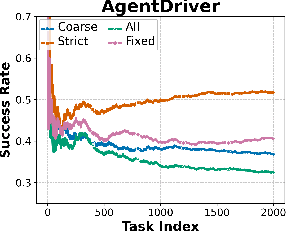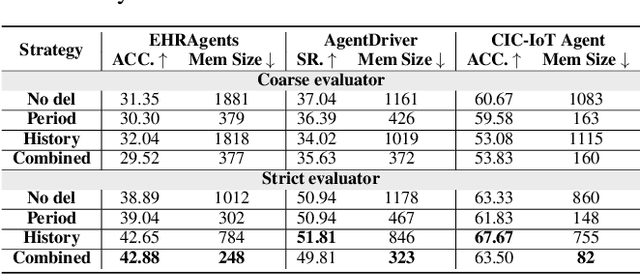Jiliang Tang
TRAJECT-Bench:A Trajectory-Aware Benchmark for Evaluating Agentic Tool Use
Oct 06, 2025



Abstract:Large language model (LLM)-based agents increasingly rely on tool use to complete real-world tasks. While existing works evaluate the LLMs' tool use capability, they largely focus on the final answers yet overlook the detailed tool usage trajectory, i.e., whether tools are selected, parameterized, and ordered correctly. We introduce TRAJECT-Bench, a trajectory-aware benchmark to comprehensively evaluate LLMs' tool use capability through diverse tasks with fine-grained evaluation metrics. TRAJECT-Bench pairs high-fidelity, executable tools across practical domains with tasks grounded in production-style APIs, and synthesizes trajectories that vary in breadth (parallel calls) and depth (interdependent chains). Besides final accuracy, TRAJECT-Bench also reports trajectory-level diagnostics, including tool selection and argument correctness, and dependency/order satisfaction. Analyses reveal failure modes such as similar tool confusion and parameter-blind selection, and scaling behavior with tool diversity and trajectory length where the bottleneck of transiting from short to mid-length trajectories is revealed, offering actionable guidance for LLMs' tool use.
Exploring Solution Divergence and Its Effect on Large Language Model Problem Solving
Sep 26, 2025Abstract:Large language models (LLMs) have been widely used for problem-solving tasks. Most recent work improves their performance through supervised fine-tuning (SFT) with labeled data or reinforcement learning (RL) from task feedback. In this paper, we study a new perspective: the divergence in solutions generated by LLMs for a single problem. We show that higher solution divergence is positively related to better problem-solving abilities across various models. Based on this finding, we propose solution divergence as a novel metric that can support both SFT and RL strategies. We test this idea on three representative problem domains and find that using solution divergence consistently improves success rates. These results suggest that solution divergence is a simple but effective tool for advancing LLM training and evaluation.
Subgraph Generation for Generalizing on Out-of-Distribution Links
Jul 15, 2025Abstract:Graphs Neural Networks (GNNs) demonstrate high-performance on the link prediction (LP) task. However, these models often rely on all dataset samples being drawn from the same distribution. In addition, graph generative models (GGMs) show a pronounced ability to generate novel output graphs. Despite this, GGM applications remain largely limited to domain-specific tasks. To bridge this gap, we propose FLEX as a GGM framework which leverages two mechanism: (1) structurally-conditioned graph generation, and (2) adversarial co-training between an auto-encoder and GNN. As such, FLEX ensures structural-alignment between sample distributions to enhance link-prediction performance in out-of-distribution (OOD) scenarios. Notably, FLEX does not require expert knowledge to function in different OOD scenarios. Numerous experiments are conducted in synthetic and real-world OOD settings to demonstrate FLEX's performance-enhancing ability, with further analysis for understanding the effects of graph data augmentation on link structures. The source code is available here: https://github.com/revolins/FlexOOD.
How Memory Management Impacts LLM Agents: An Empirical Study of Experience-Following Behavior
May 21, 2025



Abstract:Memory is a critical component in large language model (LLM)-based agents, enabling them to store and retrieve past executions to improve task performance over time. In this paper, we conduct an empirical study on how memory management choices impact the LLM agents' behavior, especially their long-term performance. Specifically, we focus on two fundamental memory operations that are widely used by many agent frameworks-addition, which incorporates new experiences into the memory base, and deletion, which selectively removes past experiences-to systematically study their impact on the agent behavior. Through our quantitative analysis, we find that LLM agents display an experience-following property: high similarity between a task input and the input in a retrieved memory record often results in highly similar agent outputs. Our analysis further reveals two significant challenges associated with this property: error propagation, where inaccuracies in past experiences compound and degrade future performance, and misaligned experience replay, where outdated or irrelevant experiences negatively influence current tasks. Through controlled experiments, we show that combining selective addition and deletion strategies can help mitigate these negative effects, yielding an average absolute performance gain of 10% compared to naive memory growth. Furthermore, we highlight how memory management choices affect agents' behavior under challenging conditions such as task distribution shifts and constrained memory resources. Our findings offer insights into the behavioral dynamics of LLM agent memory systems and provide practical guidance for designing memory components that support robust, long-term agent performance. We also release our code to facilitate further study.
Higher-order Structure Boosts Link Prediction on Temporal Graphs
May 21, 2025Abstract:Temporal Graph Neural Networks (TGNNs) have gained growing attention for modeling and predicting structures in temporal graphs. However, existing TGNNs primarily focus on pairwise interactions while overlooking higher-order structures that are integral to link formation and evolution in real-world temporal graphs. Meanwhile, these models often suffer from efficiency bottlenecks, further limiting their expressive power. To tackle these challenges, we propose a Higher-order structure Temporal Graph Neural Network, which incorporates hypergraph representations into temporal graph learning. In particular, we develop an algorithm to identify the underlying higher-order structures, enhancing the model's ability to capture the group interactions. Furthermore, by aggregating multiple edge features into hyperedge representations, HTGN effectively reduces memory cost during training. We theoretically demonstrate the enhanced expressiveness of our approach and validate its effectiveness and efficiency through extensive experiments on various real-world temporal graphs. Experimental results show that HTGN achieves superior performance on dynamic link prediction while reducing memory costs by up to 50\% compared to existing methods.
Enhancing LLM-Based Short Answer Grading with Retrieval-Augmented Generation
Apr 07, 2025



Abstract:Short answer assessment is a vital component of science education, allowing evaluation of students' complex three-dimensional understanding. Large language models (LLMs) that possess human-like ability in linguistic tasks are increasingly popular in assisting human graders to reduce their workload. However, LLMs' limitations in domain knowledge restrict their understanding in task-specific requirements and hinder their ability to achieve satisfactory performance. Retrieval-augmented generation (RAG) emerges as a promising solution by enabling LLMs to access relevant domain-specific knowledge during assessment. In this work, we propose an adaptive RAG framework for automated grading that dynamically retrieves and incorporates domain-specific knowledge based on the question and student answer context. Our approach combines semantic search and curated educational sources to retrieve valuable reference materials. Experimental results in a science education dataset demonstrate that our system achieves an improvement in grading accuracy compared to baseline LLM approaches. The findings suggest that RAG-enhanced grading systems can serve as reliable support with efficient performance gains.
LLM-based Automated Grading with Human-in-the-Loop
Apr 07, 2025Abstract:The rise of artificial intelligence (AI) technologies, particularly large language models (LLMs), has brought significant advancements to the field of education. Among various applications, automatic short answer grading (ASAG), which focuses on evaluating open-ended textual responses, has seen remarkable progress with the introduction of LLMs. These models not only enhance grading performance compared to traditional ASAG approaches but also move beyond simple comparisons with predefined "golden" answers, enabling more sophisticated grading scenarios, such as rubric-based evaluation. However, existing LLM-powered methods still face challenges in achieving human-level grading performance in rubric-based assessments due to their reliance on fully automated approaches. In this work, we explore the potential of LLMs in ASAG tasks by leveraging their interactive capabilities through a human-in-the-loop (HITL) approach. Our proposed framework, GradeHITL, utilizes the generative properties of LLMs to pose questions to human experts, incorporating their insights to refine grading rubrics dynamically. This adaptive process significantly improves grading accuracy, outperforming existing methods and bringing ASAG closer to human-level evaluation.
Empowering GraphRAG with Knowledge Filtering and Integration
Mar 18, 2025Abstract:In recent years, large language models (LLMs) have revolutionized the field of natural language processing. However, they often suffer from knowledge gaps and hallucinations. Graph retrieval-augmented generation (GraphRAG) enhances LLM reasoning by integrating structured knowledge from external graphs. However, we identify two key challenges that plague GraphRAG:(1) Retrieving noisy and irrelevant information can degrade performance and (2)Excessive reliance on external knowledge suppresses the model's intrinsic reasoning. To address these issues, we propose GraphRAG-FI (Filtering and Integration), consisting of GraphRAG-Filtering and GraphRAG-Integration. GraphRAG-Filtering employs a two-stage filtering mechanism to refine retrieved information. GraphRAG-Integration employs a logits-based selection strategy to balance external knowledge from GraphRAG with the LLM's intrinsic reasoning,reducing over-reliance on retrievals. Experiments on knowledge graph QA tasks demonstrate that GraphRAG-FI significantly improves reasoning performance across multiple backbone models, establishing a more reliable and effective GraphRAG framework.
A Survey on Post-training of Large Language Models
Mar 08, 2025Abstract:The emergence of Large Language Models (LLMs) has fundamentally transformed natural language processing, making them indispensable across domains ranging from conversational systems to scientific exploration. However, their pre-trained architectures often reveal limitations in specialized contexts, including restricted reasoning capacities, ethical uncertainties, and suboptimal domain-specific performance. These challenges necessitate advanced post-training language models (PoLMs) to address these shortcomings, such as OpenAI-o1/o3 and DeepSeek-R1 (collectively known as Large Reasoning Models, or LRMs). This paper presents the first comprehensive survey of PoLMs, systematically tracing their evolution across five core paradigms: Fine-tuning, which enhances task-specific accuracy; Alignment, which ensures alignment with human preferences; Reasoning, which advances multi-step inference despite challenges in reward design; Efficiency, which optimizes resource utilization amidst increasing complexity; and Integration and Adaptation, which extend capabilities across diverse modalities while addressing coherence issues. Charting progress from ChatGPT's foundational alignment strategies to DeepSeek-R1's innovative reasoning advancements, we illustrate how PoLMs leverage datasets to mitigate biases, deepen reasoning capabilities, and enhance domain adaptability. Our contributions include a pioneering synthesis of PoLM evolution, a structured taxonomy categorizing techniques and datasets, and a strategic agenda emphasizing the role of LRMs in improving reasoning proficiency and domain flexibility. As the first survey of its scope, this work consolidates recent PoLM advancements and establishes a rigorous intellectual framework for future research, fostering the development of LLMs that excel in precision, ethical robustness, and versatility across scientific and societal applications.
A Practical Memory Injection Attack against LLM Agents
Mar 05, 2025



Abstract:Agents based on large language models (LLMs) have demonstrated strong capabilities in a wide range of complex, real-world applications. However, LLM agents with a compromised memory bank may easily produce harmful outputs when the past records retrieved for demonstration are malicious. In this paper, we propose a novel Memory INJection Attack, MINJA, that enables the injection of malicious records into the memory bank by only interacting with the agent via queries and output observations. These malicious records are designed to elicit a sequence of malicious reasoning steps leading to undesirable agent actions when executing the victim user's query. Specifically, we introduce a sequence of bridging steps to link the victim query to the malicious reasoning steps. During the injection of the malicious record, we propose an indication prompt to guide the agent to autonomously generate our designed bridging steps. We also propose a progressive shortening strategy that gradually removes the indication prompt, such that the malicious record will be easily retrieved when processing the victim query comes after. Our extensive experiments across diverse agents demonstrate the effectiveness of MINJA in compromising agent memory. With minimal requirements for execution, MINJA enables any user to influence agent memory, highlighting practical risks of LLM agents.
 Add to Chrome
Add to Chrome Add to Firefox
Add to Firefox Add to Edge
Add to Edge